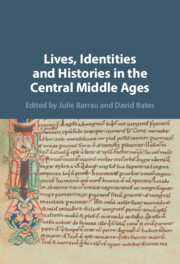Book contents
- Lives, Identities and Histories in the Central Middle Ages
- Lives, Identities and Histories in the Central Middle Ages
- Copyright page
- Contents
- Figures
- Contributors
- Abbreviations
- Introduction
- Part I Entwined Lives and Multiple Identities
- 1 Mother and Motherhood in the Vita et Passio Willelmi Norwicensis
- 2 Prayer for the Dead:
- 3 Authority over Men and the Allocation of Riches:
- 4 Flemish Settlement and Maritime Traffic in the South-West Peninsula of Britain, c. 1050–1250
- 5 Cistercians and the Laity in Twelfth- and Thirteenth-Century Upper Normandy
- 6 Memory and Trauma:
- 7 New Charters of the Empress Matilda, with Particular Reference to Her Reception at Gloucester in 1139
- 8 Female Identity before 1250:
- Part II Historians, Lawyers and Exegetes: Writing Lives and Identities
- Index
5 - Cistercians and the Laity in Twelfth- and Thirteenth-Century Upper Normandy
from Part I - Entwined Lives and Multiple Identities
Published online by Cambridge University Press: 24 September 2021
- Lives, Identities and Histories in the Central Middle Ages
- Lives, Identities and Histories in the Central Middle Ages
- Copyright page
- Contents
- Figures
- Contributors
- Abbreviations
- Introduction
- Part I Entwined Lives and Multiple Identities
- 1 Mother and Motherhood in the Vita et Passio Willelmi Norwicensis
- 2 Prayer for the Dead:
- 3 Authority over Men and the Allocation of Riches:
- 4 Flemish Settlement and Maritime Traffic in the South-West Peninsula of Britain, c. 1050–1250
- 5 Cistercians and the Laity in Twelfth- and Thirteenth-Century Upper Normandy
- 6 Memory and Trauma:
- 7 New Charters of the Empress Matilda, with Particular Reference to Her Reception at Gloucester in 1139
- 8 Female Identity before 1250:
- Part II Historians, Lawyers and Exegetes: Writing Lives and Identities
- Index
Summary
Chapter 5 considers the relationships between Cistercian communities and lay society in twelfth- and thirteenth-century Upper Normandy. Episcopal visitation records and other sources reveal that there was considerable contact and interdependence between Cistercian religious and the laity in this period, and that the boundary between the monastic precinct and the world outside was permeable. As well as accommodating lay brethren and servants, Cistercian monks and nuns offered charity and hospitality. While female communities such as Bondeville took in children and vulnerable adults, the monks of Beaubec built housing for the poor inRouen. In turn, the benefaction that these communities received from patrons created lasting links with lay society. The burial and commemoration facilities that Cistercian monasteries offered to burgess families demonstrate how the they became nodes in mutually beneficial social networks of religious and laity. Other links were more pragmatic, especially financial interactions with the Jews of Rouen. The chapter also sheds light on the lives and identities of lay women and men from arange of backgrounds, from royal patrons to disabled lay sisters.
Keywords
- Type
- Chapter
- Information
- Publisher: Cambridge University PressPrint publication year: 2021



